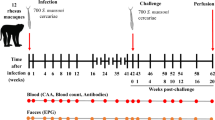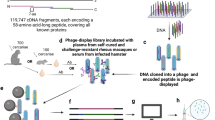Abstract
HOST antigen uptake by schistosomes is generally considered from circumstantial evidence to be a potent mechanism by which schistosomes can evade immune response and has therefore stimulated several investigations on the chemical nature of the molecules as well as their possible mode of incorporation1. These studies have indicated that the parasite can acquire host material in the form of glycolipids of erythrocyte origin2 and gene products of the murine major histocompatibility complex3. As an alternative to host antigen incorporation, the possibility of immunological blockade has been suggested. Host immunoglobulins have been demonstrated to be associated with the tegumental surfaces of Schistosoma mansoni from mice and baboons, and recent experiments4,5 have shown the presence of heterospecific antibody on the tegumental surface of S. mansoni adult worms. The ability of adsorbed antibodies to bind their respective antigens indicates that some of these immunoglobulins are orientated so as to present at least one free Fab region of the antibody molecule. Although this could merely represent a nonspecific adsorption, it could also represent the specific binding of the immunoglobulin on the parasite's surface. Using a rosette test we have now demonstrated the presence of receptors for both IgG(Fc) and human β2-microglobulin.
This is a preview of subscription content, access via your institution
Access options
Subscribe to this journal
Receive 51 print issues and online access
$199.00 per year
only $3.90 per issue
Buy this article
- Purchase on SpringerLink
- Instant access to full article PDF
Prices may be subject to local taxes which are calculated during checkout
Similar content being viewed by others
References
Smithers, S. R. & Terry, R. J. Adv. Parasit. 14, 399–422 (1976).
Goldring, O. L., Kusel, J. R. & Smithers, S. R. Expl Parasit. 43, 82–93 (1977).
Sher, A., Hall, B. F. & Vadas, M. A. J. exp. Med. 148, 46–57 (1978).
Kemp, W. M., Merritt, S. C., Bogucki, M. S., Rosier, J. G. & Seed, J. R. J. Immun. 119, 1849–1854 (1977).
Kemp, W. M., Merritt, S. C. & Rosier, J. G. Expl Parasit. 45, 81–87 (1978).
Clegg, J. A. & Smithers, S. R. Int. J. Parasit. 2, 79–98 (1972).
Ramalho-Pinto, F. J. et al. Expl Parasit. 36, 360–372 (1974).
Stirewalt, M. A. & Dorsey, C. H. Expl Parasit. 35, 1–15 (1974).
Porter, R. R. Biochem. J. 73, 119 (1959).
Author information
Authors and Affiliations
Rights and permissions
About this article
Cite this article
TORPIER, G., CAPRON, A. & OUAISSI, M. Receptor for IgG(Fc) and human β2-microglobulin on S. mansoni schistosomula. Nature 278, 447–449 (1979). https://doi.org/10.1038/278447a0
Received:
Accepted:
Issue date:
DOI: https://doi.org/10.1038/278447a0
This article is cited by
-
Irradiated larval vaccination and antibody responses evaluated in relation to the expression of immunity to Heligmosomoides polygyrus
Parasitology Research (1996)
-
FcR may function as a progression factor of nonlymphoid tumors
Immunologic Research (1992)
-
Parasites and molecular biology
Experientia (1991)
-
Possible role of microbial IgG Fc-binding proteins in rheumatoid arthritis
Agents and Actions (1990)
-
Biology of tegument associated IgG-Fc and C3 receptors inSchistosoma mansoni
Journal of Chemical Ecology (1986)



